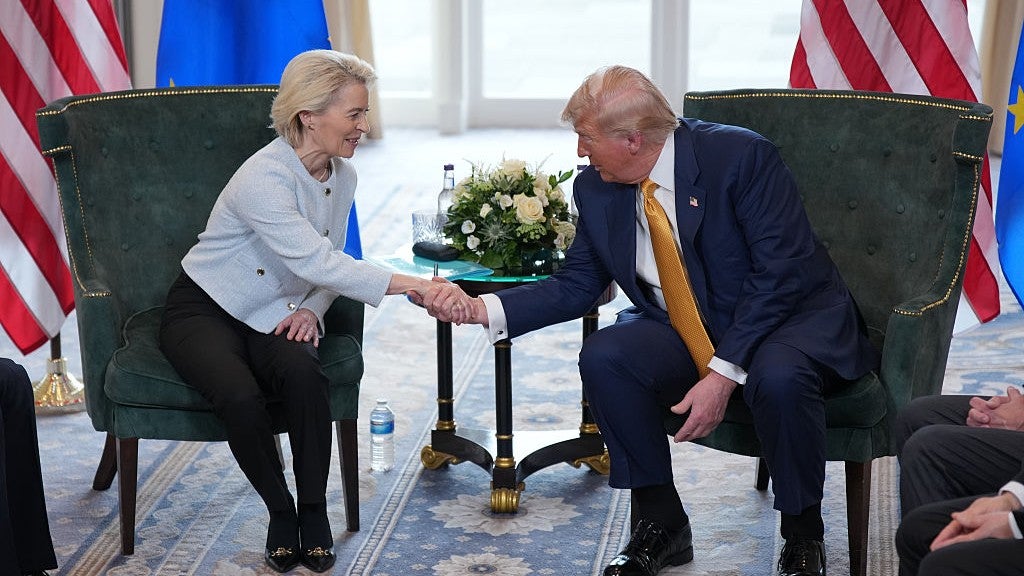The much-awaited EU-US trade deal has landed amid significant controversy, with many viewing it as a major concession by Brussels to the Trump administration. Under the new agreement, the European Union has accepted a 15% tariff on approximately 70% of its exports to the United States, a substantial increase from the current average rate of 4.8%, while US exports to the EU will face zero tariffs.
“It is a dark day when an alliance of free peoples, brought together to affirm their common va
...
The much-awaited EU-US trade deal has landed amid significant controversy, with many viewing it as a major concession by Brussels to the Trump administration. Under the new agreement, the European Union has accepted a 15% tariff on approximately 70% of its exports to the United States, a substantial increase from the current average rate of 4.8%, while US exports to the EU will face zero tariffs.
“It is a dark day when an alliance of free peoples, brought together to affirm their common values and to defend their common interests, resigns itself to submission,” French Prime Minister François Bayrou stated in a social media post, reflecting the deep concerns among some European leaders.
The automotive sector, particularly crucial to Germany’s economy, will see tariffs reduced from the previously threatened 27.5% to the 15% baseline. This mirrors the rate that Japan secured for its automakers in its recent agreement with the US last week.
EU Commission President Ursula von der Leyen announced on Sunday that certain products will be exempt from the 15% tariff rate, including aircraft and aircraft components, some agricultural products, certain chemicals, critical raw materials, natural resources, and semiconductors. These exemptions appear targeted at goods essential to US domestic demand and strategic objectives.
Despite initial confusion, the pharmaceutical sector will be subject to the 15% tariff, potentially increasing industry costs by $13 billion to $19 billion annually, according to market analysts.
Beyond tariffs, the agreement includes significant purchasing and investment commitments. The EU has pledged to buy €750 billion ($865 billion) worth of US natural gas, oil, and nuclear technology during the next three years of Trump’s term—equating to an annual expenditure of €250 billion. Additionally, European companies have committed to investing €600 billion into the United States, though no specific timeline or implementation plan was provided for this massive capital flow.
Experts have expressed skepticism about these commitments. Davide Oneglio, director of European and global macroeconomics at TS Lombard, characterized the deal as “a bad one in absolute terms, an OK one relative to other countries.” Regarding the foreign direct investment and energy purchase pledges, Oneglio dismissed them as “theatre and not legally binding.”
“As [TS Lombard] anticipated since April, the EU’s strategy is ‘over-promising and under-delivering,’ in line with its own experience during Trump 1.0 and China’s ‘phase 1 deal’. Unsurprisingly, Trump is already portraying such promises as ‘wins’, but nothing is legally binding,” Oneglia explained.
The €750 billion energy import commitment appears particularly unrealistic. “The huge figure cited in connection with energy imports (over three years) is meaningless, as it is unachievable not only because EU demand cannot grow that much but also because US exporters cannot supply that much either,” Oneglio noted.
Similarly, the €600 billion foreign direct investment pledge faces scrutiny. Oneglio pointed out that “as the EU is not China and cannot direct the private sector, that figure is meaningless too, with the EU already calling it an ‘intention’ and ‘no guarantee’.”
TS Lombard’s chief US economist Steven Blitz offered additional perspective: “Europe only accepts 15% because it knows it is doing the same to the US either through specific tariffs or non-tariff barriers.” He suggested the tariffs might primarily serve as revenue for the US government, noting they represent a shift “from an income tax to a consumption tax to fund the government.”
The deal comes at a time of heightened economic uncertainty in transatlantic relations, with businesses on both sides of the Atlantic having weathered significant disruptions since President Trump’s first round of tariffs. While providing some clarity, the agreement has already faced strong backlash from within the EU leadership, highlighting deep divisions in the bloc’s approach to trade negotiations with the United States.
As implementation details continue to emerge, businesses across multiple sectors are now recalibrating their transatlantic strategies to account for the new tariff landscape and assessing the real-world impact of what many analysts consider a one-sided agreement.


